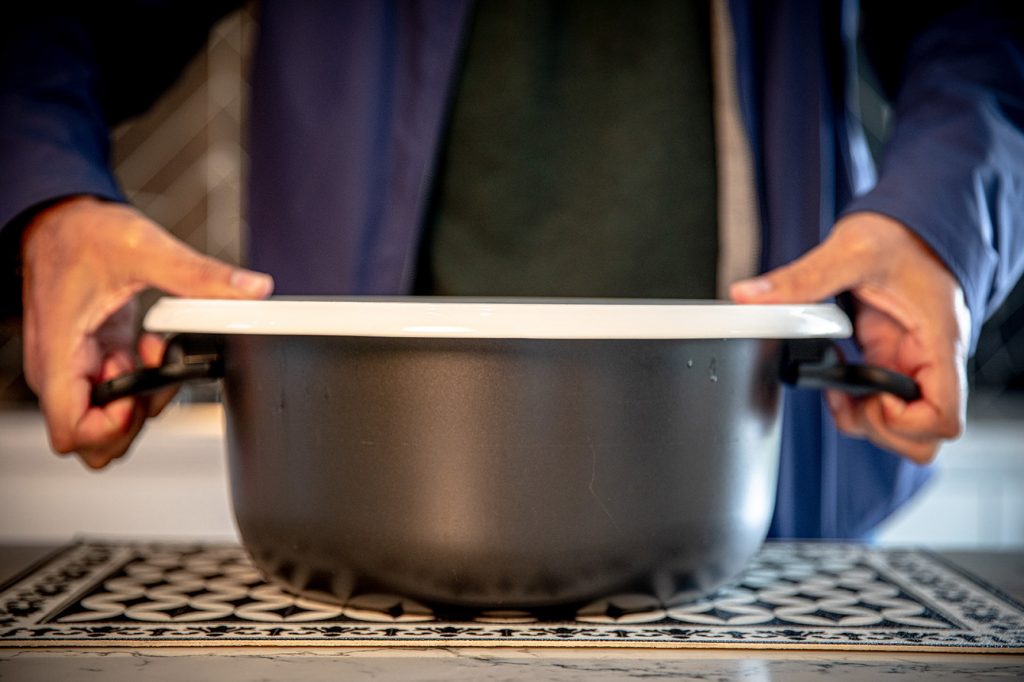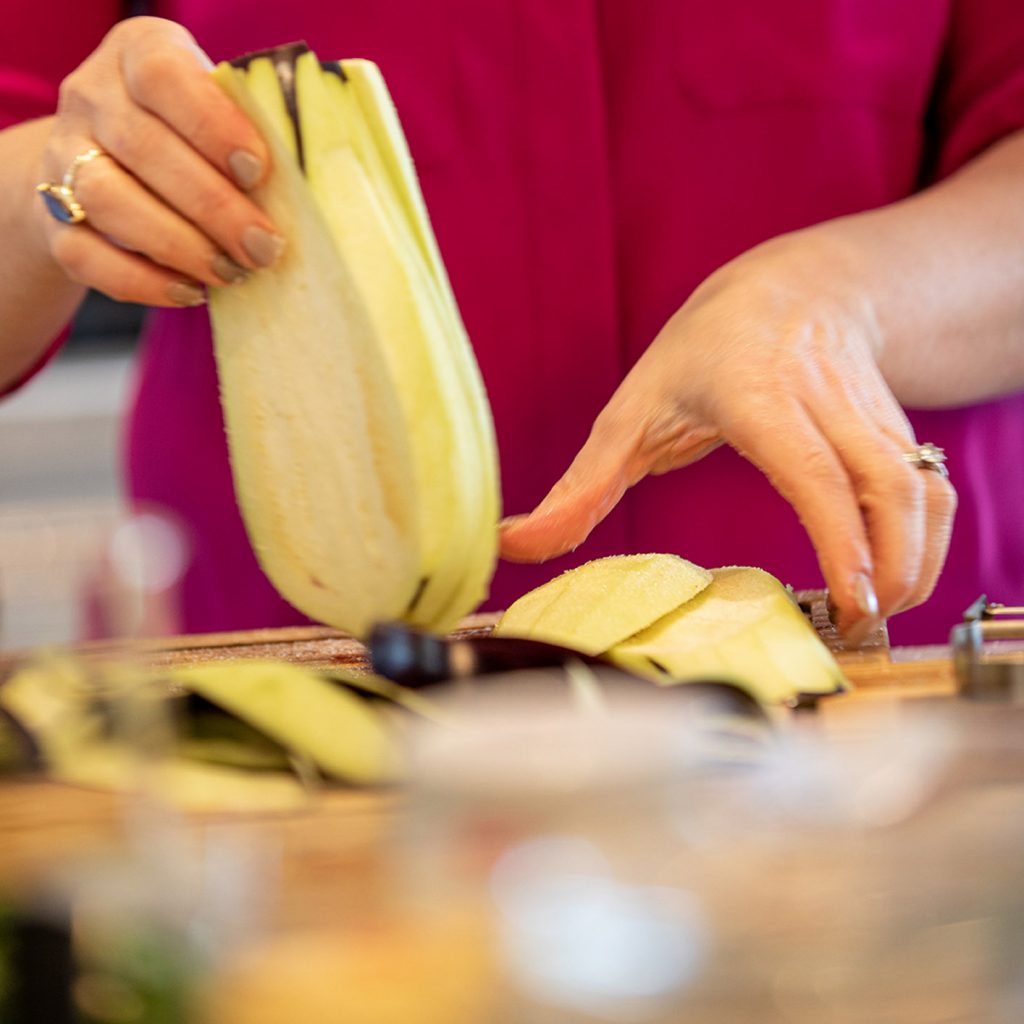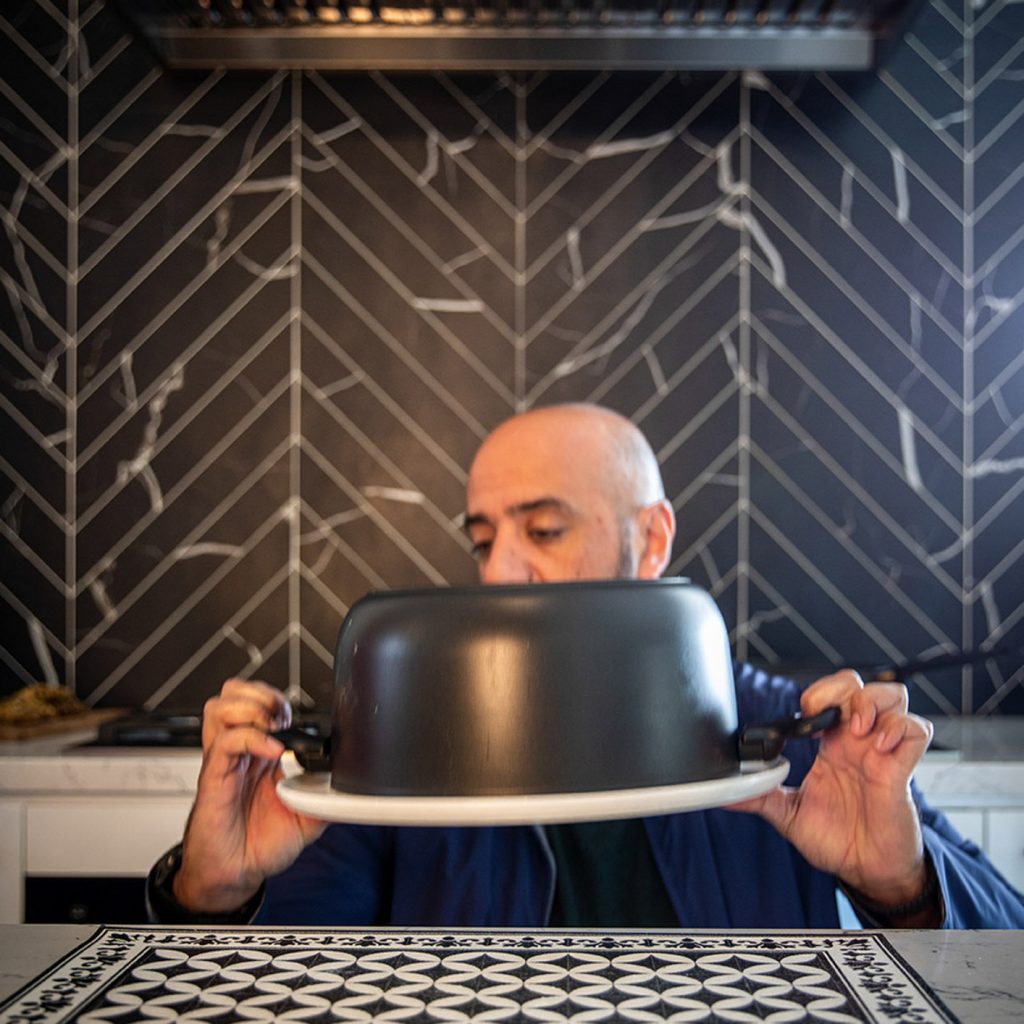Maqloubi (also spelled maqluba or maklouba) is one of my favourite one-pot meals for either dinner parties or just a casual family dinner. It’s a traditional recipe originating from Palestine, but it’s also quite popular in Syria and Lebanon.

There are two main things that make this dish so unique: first, the layering of rice, meat, and vegetables that give it a cake-like look, and second, the heart-stopping moment when you flip the pot onto a serving plate to reveal your beautiful creation. You can check out the step-by-step recipe, here.
Not long ago, I filmed a fun cooking session for this upside-down dish on Instagram Stories with Aunty Omaya, one of our dear family friends. I thought that it would be great to share with you all the tips and tricks I’ve learned from her in a journal.
So, without further ado, here’s how you can cook the perfect Maqloubi every time:
1. Divide your tasks in a smart way.
You can prepare some of the ingredients for this dish at the same time, which will cut the time you spend in the kitchen almost in half. For example, while the chicken is simmering on the stove (which will take about 45 minutes), go and fry the pine nuts.
Also, while you’re frying the eggplants, let the rice soak for at least 10 minutes, then wash, drain and season it.
2. Choose the right pot and serving platter.
You need a pot that has the same diameter all the way through rather than one that is narrower at the bottom.
Make sure that the handles on either side of the pot are lower, which will help you a lot when you’re flipping it upside down while serving the dish. In my case, my husband, Gus, turned the handles of my pot upside down, which made it the ideal pot for this recipe.

Finally, it’s essential to find the right flat plate that will sit flush on top of the pot. It needs to be well sealed; otherwise, when you’re flipping the pot, you risk spilling the food.

3. Simmer the chicken, don’t poach it.
When you prepare the homemade chicken stock, I suggest you boil the chicken rather than poach it to get the best flavour for your stock. Don’t forget to salt your stock once finished; otherwise, your dish will lack seasoning.
Moreover, when it’s time to add the stock over the layers you’ve built in your pot, pour it over a skimmer or a large serving spoon. This way you won’t disturb the layering or create holes in the rice.

Make sure to keep the chicken pieces you’ve boiled in chunks as this will make your layers more visually appealing once the dish is turned upside down. If you shred the chicken pieces too finely, you will lose that effect as the chicken layer will mix with the eggplant one.
4. Prepare the eggplants properly before cooking them.
Choose longer fresh eggplants as they are visually more appealing and fit better around the pot. Slice them lengthwise approximately 1 ½ cm thick. If you cut them too thin, they won’t hold their shape and will fall apart while assembling in the pot.


Take the eggplant slices and salt them to reduce moisture and bitterness. Then, place them upright in a colander for at least 1 hour to drain the water.

Before frying the eggplant, pat dry them with a paper towel to remove excess water and prevent the oil from splattering.

Remember to layer paper towels in between the stir-fried eggplant slices to absorb excess oil. You’ll use at least half of these slices to line the pot with, so you need them to be firm and maintain their shape to overlap diagonally for a delightful visual presentation of the dish.
Shallow frying won’t give you the same results, and the eggplants might not stand around the pot or maintain their shape as they should.

5. Use enough oil when frying.
I always use rice bran oil when stir-frying because it has a high burning point. However, you can use any vegetable oil you like for this recipe.
6. Adding potato slices at the bottom of the pot.
Potatoes prevent the chicken from burning at the base of the pot and eggplants from sticking and burning.

Cut your potatoes in 2-3 cm thick slices so they hold their shape.
Also, don’t forget to season the potatoes even if they’re not part of the main dish. Once the pot is flipped, they are removed and eaten separately. They’re so delicious that in our home, we usually polish them off before we serve dinner.
7. Use the exact quantity of rice, it’s all about balance.
Always cook the exact quantity of rice indicated in the recipe so that all the layers (rice, eggplant, and meat) are more or less equal, making it proportionally balanced.
You can use any rice. I highly recommend Jasmine rice as I love the floral aroma it naturally has. Once cooked, Jasmine rice has a soft and sticky texture.
Make sure to rinse the rice thoroughly. This will thin out the layer of starch and also separate the grains so the rice doesn’t stick together.
Remember to soak the rice for at least 20 minutes. This will make it increase in volume and require less water when cooking, speeding up the cooking process.

8. Be careful when you flip the pot upside down.
This is a very gentle process and the most exciting part of your recipe. Flipping the maqloubi dish in front of your guests is like a magic act. If done right, you’ll leave them in awe.
Let your maqloubi sit for at least 10 minutes before flipping. You want the food layering to settle a bit. Once you commit to the flip, you mustn’t hesitate if you want it to keep its cake-like appearance.

I also think it’s wise to find the right person in your family to flip the pot as it can be quite heavy. My husband, Gus is usually the one who flips the pots in our home, which literally takes a load off my shoulders.

9. Add pine nuts on top for a beautiful garnish.
If you’re serving this for a dinner party, I highly encourage you to scatter those golden pine nuts on top. If this is your family dinner, then you may skip this step.

All in all, maqloubi is an excellent dish for entertaining as it’s both visually beautiful and delicious to serve to your guests. You can make the layering the night before the party but don’t add the chicken stock yet. Just cover the pot with a lid and refrigerate overnight. The next day, all you have to do is add the stock before you cook.
For a step-by-step video and recipe, click here.
Enjoy, and if you try this recipe, don’t forget to tag me on Instagram for a chance to be featured in my stories!
Sahtan – Enjoy In Good Health






6 Responses
Can you please let me know what pot you have ?
I’m using the esteele pot here
I use different pots for different dishes, currently I’m using the woll diamond pot and for certain dishes i use the dorsch home Australia. Here’s a link for dorsch ware that also gets you 10% off if you use my code “roubasfood” https://dorschhome.com.au/?coupon-code=roubasfood&sc-page=shop
Usually I do not read article on blogs however I would like to say that this writeup very compelled me to take a look at and do so Your writing taste has been amazed me Thanks quite nice post
Thank you so much for these useful tips. I am planning to cook this dish for the first time for a group of friends on Easter Sunday. Am very grateful for your detailed tips. Bit worried about what pot to use. I have to make it vegetarian so going to add cauliflower and other veg.
don’t be nervous, it will either flip or not but it will be very delicious regardless!!! use a non stick pot with a flat round base and make sure the platter you’re flipping into sits on top so those handles are not in the way unless you have a family member who would be a pro at flipping!! please share your creations with me